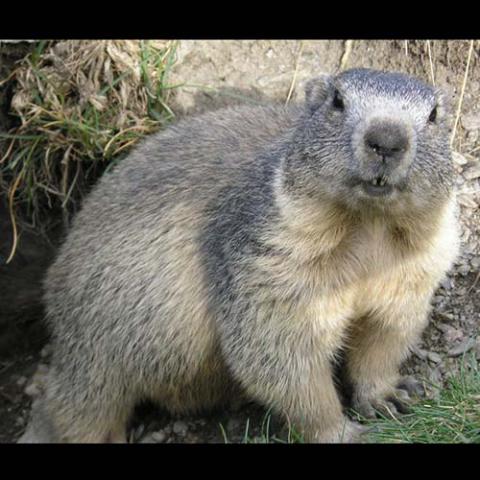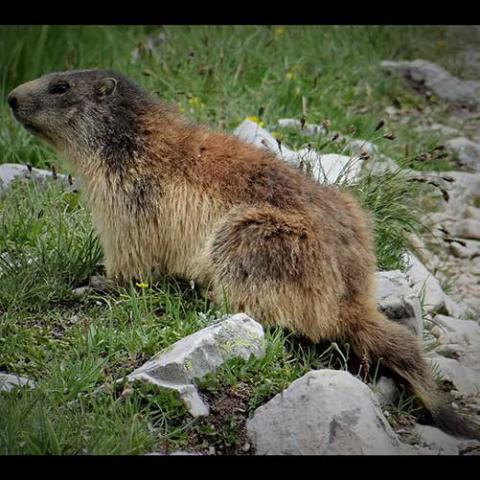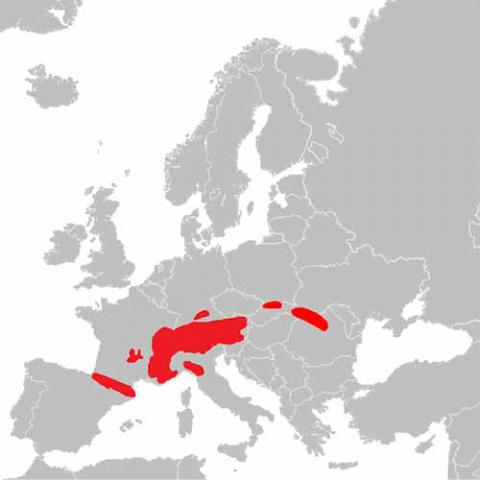NAMES
TAXONOMY
Czechoslovakia
Issued:
Stamp:
Marmota marmota
Czechoslovakia
Issued:
Stamp:
Marmota marmota
Czechoslovakia
Issued:
Stamp:
Marmota marmota
Genus species (Animalia): Marmota marmota
The alpine marmot (Marmota marmota) is a large ground-dwelling squirrel, from the genus of marmots. It is found in high numbers in mountainous areas of central and southern Europe, at heights between 800 and 3,200 m (2,600–10,500 ft) in the Alps, Carpathians, Tatras and Northern Apennines. In 1948 they were reintroduced with success in the Pyrenees, where the alpine marmot had disappeared at end of the Pleistocene epoch.
Evolution
The alpine marmot originates as an animal of Pleistocene cold steppe, exquisitely adapted to this ice-age climate. As such, alpine marmots are excellent diggers, able to penetrate soil that even a pickaxe would have difficulty with, and spend up to nine months per year in hibernation.
Since the disappearance of the Pleistocene cold steppe, the alpine marmot persists in the high altitude alpine meadow. During the colonization of Alpine habitat, the alpine marmot has lost most of its genetic diversity through a bottleneck effect. It could not rebuild its genetic diversity ever since, as its lifestyle adapted to the Ice Age climate slowed its rate of genomic evolution. The alpine marmot is indeed one of the least genetically diverse wild-living animals.
Description
An adult alpine marmot is between 43 and 73 cm (17–29 in) in head-and-body length and the tail measures from 13 to 20 cm (5–8 in). The body mass ranges from 1.9 to 8 kg (4.2–17.6 lb), with the animals being significantly lighter in the spring (just after hibernation) than in the autumn (just before hibernation). The alpine marmot is sometimes considered the heaviest squirrel species, although some other marmot species have a similar weight range, making it unclear exactly which is the largest. Its coat is a mixture of blonde, reddish and dark gray fur. While most of the alpine marmot's fingers have claws, its thumbs have nails.
Range and Ecology
As its name suggests, the alpine marmot ranges throughout the European Alps, ranging through alpine areas of France, Italy, Switzerland, Germany, Slovenia, Slovakia and Austria. They have also been introduced elsewhere with sub-populations in the Pyrenees, France's Massif Central, Jura, Vosges, Black Forest, Apennine Mountains, and the Romanian Carpathians. The Tatra marmot (Marmota marmota latirostris Kratochvíl, 1961) represents an endemic subspecies of Alpine marmot that originated during the Quaternary period. Tatra marmots inhabit Tatry Mountains and Nízke Tatry Mountains. Marmots are abundant in their core population; in the Romanian Carpathians, for example, the population is estimated at 1,500 individuals. Alpine marmots prefer alpine meadows and high-altitude pastures, where colonies live in deep burrow systems situated in alluvial soil or rocky areas.
Marmots may be seen "sun bathing", but actually this is often on a flat rock and it is believed they are actually cooling and possibly this is a strategy to deal with parasites. Marmots are temperature sensitive and an increase in temperature can cause habitat loss for the species as a whole.
Diet
Alpine marmots eat plants such as grasses and herbs, as well as grain, insects, spiders and worms. They prefer young and tender plants over any other kind, and hold food in their forepaws while eating. They mainly emerge from their burrows to engage in feeding during the morning and afternoon, as they are not well suited to heat, which may result in them not feeding at all on very warm days. When the weather is suitable, they will consume large amounts of food in order to create a layer of fat on their body, enabling them to survive their long hibernation period.
Reference: Wikipedia




